We’ve covered a lot of urban ground in the past year, so we thought it would be fun to take a look back (and a couple of peeks forward) by going from A to Z in the urban alphabet. Here are some of the things we’ve been watching, and will continue to school ourselves on.
A RC Tunnel: When New Jersey Gov. Chris Christie singlehandedly put the brakes on the biggest public works project in America, he sent a signal to Washington that a lot of governors out there seem to be echoing: You can’t make me take on infrastructure projects I don’t want to (See “High-speed rail,” below).
Whether you think Christie is a fiscally responsible hero or a short-sighted grandstanding obstructionist, you’ve got to admit he gained clout and recognition for his actions. And considering how often he’s being mentioned as a presidential contender, that’s probably just fine with him.
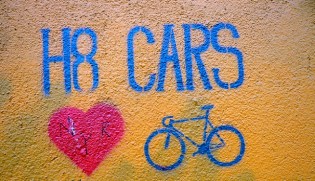
Photo by Svennevenn.
Bicycles as transportation: This has been a banner year for people who use bikes to get around. From the creation of hundreds of miles of bike lanes in New York, to the launch of bike-share systems in Denver and Washington, D.C., to the bike-friendly statements of U.S. DOT Secretary Ray LaHood at the Bike Summit, there’s real momentum for the idea that two-wheeled transport can be a meaningful alternative. Grist columnist Elly Blue will continue to cover all the latest developments.
Civil rights and transportation policy: In October, I had a conversation with Angela Glover Blackwell of PolicyLink about transportation as a civil rights and social justice issue. It’s a connection, she pointed out, that runs all the way from Plessy v. Ferguson to Rosa Parks to the Freedom Riders to urban renewal and the abandonment of the inner city for highway culture.
Today, said Blackwell, the battle to maintain our public transportation systems in the face of budget cuts is another chapter in that
history, and “we’re beginning to see a movement stirring all across the country of people making their voices heard on this issue.”
Detroit: Battered but still standing, this Michigan city has become the poster child for what’s wrong with Rust Belt America — and for what could go right in the future. Tom Philpott made a trip to see what new agricultural initiatives are sprouting up through the cracked streets of the city. He spoke with Ashley Atkinson of Greening of Detroit, who said this: “[I]f you’re here in the city, you cannot hide from poverty and suffering. It’s right there in your face. You can either embrace humanity and try to live every moment to try to make everyone’s life easier, or you leave … if you have the option to.”
Tom also had one of his best meals of the year at Slows Bar-B-Q, an outpost of good cooking that represents the positive, entrepreneurial spirit that is thriving against the odds in Detroit.
Energy efficiency: Improving the energy efficiency of homes and commercial buildings in our cities is a no-brainer. We can do it on a large scale with smart grids and similar technology, and on a smaller scale by weatherizing existing homes. We can also aim for the very highest standards in the new buildings we construct.
Freeganing: Freeganing — aka Dumpster diving — is just one aspect of a bigger movement toward sharing and reusing objects and food, rather than getting caught in the hamster wheel of our throwaway culture. Bartering, sharing, and freecycling all fit into the same frame of mind. The movement is discussed by Rachel Botsman and Roo Rogers in their book, What’s Mine is Yours: The Rise of Collaborative Consumption.
Things I have freeganed or freecycled recently, in some cases giving and in some cases getting: a barely worn pair of kids’ winter
boots; a great pair of Levis 501 jeans; and perfectly good butternut squash discarded by my local produce stand. What about you?
Green roofs: They can be modest affairs, put together by a homeowner to insulate the house and provide a fine setting for a beehive or two. Or they can be full-scale urban farms. You can even find one atop Chicago’s City Hall. Green roofs are being used by some cities, including New York, as part of a larger strategy to combat sewage and wastewater runoff.
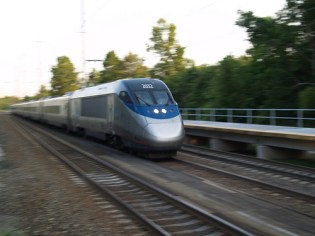
Photo: Tim Gilliam.
High-speed rail: The prospects for high-speed rail coming to the United States on a large scale looked pretty good a few months ago, when the Obama administration unveiled a plan to link many American cities with a modern train system. But as newly elected Republican governors make good on campaign pledges to scuttle their sections, the network is looking a lot less comprehensive.
Which is too bad. As recent nationwide delays in air travel have demonstrated, we could use a lot more redundancy and resiliency in our transportation systems.
Infrastructure: There’s been a lot of talk about whether infrastructure is sexy or isn’t sexy, or how we can make it that way so that people care about it (when you Google “infrastructure sexy” you get more than 900,000 results). Well, even if it dresses up in high heels and fishnets, it probably won’t be able to get the attention of a Republican Congress that is dead set against stimulative spending of any kind right now.
Which is a problem. Because the other word that goes with infrastructure a lot is “crumbling.”

Janette Sadik-Khan. (Photo by Olugbenro Ogunsemore.)
Janette Sadik-Khan: I had a chance to sit down with Sadik-Khan, New York City’s rock star Department of Transportation commissioner, a couple of weeks ago. Under her leadership, the primacy of automobiles on the city’s streets has been challenged for the first time since Robert Moses’s day. She’s pedestrianized Times Square and Herald Square, created hundreds of miles of bike lanes, and built public plazas where cars used to reign.
Here’s what she has to say to city leaders who would like to make similar changes in their communities: “The alchemy of sustainable streets is part art and part science. Be bold, have a vision, lay out where you want to go. That creates buy-in for the initiatives that you pursue.”
Kids in the city: Cities are nothing without their children. And more and more, parents are realizing that cities can be great places to raise kids. In Urban Family Values, Carla Saulter writes regularly about the ins and outs of raising kids (car-free, no less) in the city.
Livability: It’s such a simple word, and it really seems like it shouldn’t be controversial. But as with so many things these days (salad bars, anyone?), the concept of livability in planning policy has caused a rash of rage among Tea Partiers.
So what is livability, anyway? What it boils down to, as articulated by US DOT Secretary Ray LaHood (see entry under “R”, below), is this: “It’s a community where if people don’t want an automobile, they don’t have to have one.”
How un-American. Or is it?
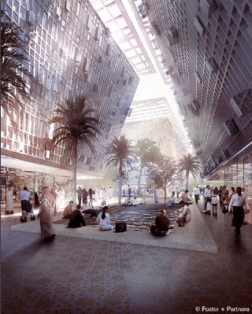
A rendering of Masdar. (Illustration by Foster + Partners.)
Model cities: They’re the latest trendy ecotopias: model custom-built cities like Masdar, in Abu Dhabi. Masdar and its cohorts make use of the latest in technology, promising that all systems will be green, all streets will be clean and controlled, and (almost) all energy will be renewable.
They make sense as laboratories for emerging technologies. But as I wrote earlier this year, I’m skeptical that these places can ever live up to the hype, or that they will ever be real cities at all.
Neighborhoods: The important part of a city is made of people, not buildings. Get to know your neighbors. They may save your ass one day.
Open data: New York’s Metropolitan Transit Authority recently launched an ad campaign saying “Our apps are whiz kid certified.” It’s promoting the MTA’s policy of opening data to developers so that they can write apps that might be useful to transit
riders. The release of such data is one way that cities can create a collaborative, dynamic, and creative engagement with citizens — and, as the MTA ad acknowledges, independent developers will probably do a better job than the agency would.
Pavement demolition: Earlier this year, I wrote about a Portland, Ore., group called Depave that helps neighbors band together to pulverize unused asphalt and create green space instead. Grab your sledgehammers, friends!
Quality of life: The way we build our streets has a huge impact on the quality of the lives we live in them. A generation ago, researcher Donald Appleyard found that people’s social lives and their sense of involvement with their communities was negatively impacted by automobile traffic. Things haven’t changed — except that there are a lot more cars now.
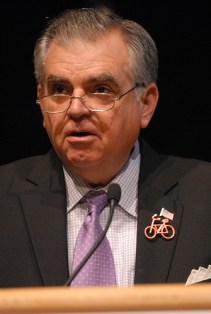
Ray LaHood.
Ray LaHood: The Obama administration’s Secretary of Transportation has emerged as an unlikely advocate for all sorts of progressive urban policies, including “livability” (see under “L,” above. He’s been a pleasant surprise to those looking to reform the way our nation thinks about transportation (meaning, people who think we might need alternatives to cars and the roads
they drive on).
I talked with LaHood earlier this year and asked him what surprised him about his time at the DOT. Here’s what he told me: “I think people have always thought of the Department of Transportation as the department that builds roads and bridges. But you can do big things, and dream big dreams, and the president has really given us the opportunity to do that.”
Sprawl: It’s ugly, it makes us sick, and it eats forests and fields alive. What can we do with all the damn sprawl we’ve created? I talked with Galina Tachieva, author of The Sprawl Repair Manual, about why fixing this broken part of our country is so important — and how we might be able to get it done.
Transit-oriented development: More and more developers and planners are seeing transit-oriented development (TOD) as a boon to cities. Building homes near transit — and sometimes building modern transit systems from scratch — is a great way to revitalize neighborhoods and keep cars off the roads.
But a recent study showed that maybe TOD is too successful. The study suggested that new transit and associated development can gentrify neighborhoods, driving out the people who use it and bringing in people who are wealthy enough to own cars — and inclined to do so.
This isn’t to say that TOD is bad for cities or people who live in them. But as Yonah Freemark pointed out in Next American City, it’s something planners should take into account.
Urban agriculture: It may have looked like a trend at first, but urban ag is proving its staying power. People are raising chickens, keeping bees, and growing their own veggies within city limits — and they’re loving it. Check out our Feeding the City series for some shining examples.
Vehicle miles traveled: It’s becoming increasingly clear that the gas tax, as it stands today, can’t sustain our transportation infrastructure — especially with cars getting more fuel-efficient, and with the rise of hybrid and electric-powered vehicles. So some people are talking about a tax on Vehicle Miles Traveled, or VMT. There’s a lot of debate over whether it’s a fair way of pricing driving, and privacy concerns about the technology used to track distances. It’s not going to become reality anytime soon. But you’ll probably be hearing more about it — and if it ever does happen, it could change the way people think about driving.
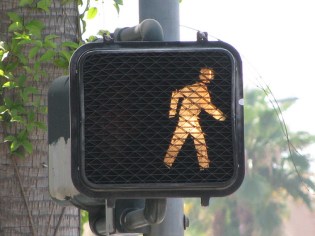 Walkable neighborhoods: Like we said above under “Q,” your quality of life is deeply connected to the place you live. A recent study found that people in walkable neighborhoods have more “social capital,” in the form of connections with other people. They also reported being happier. Which means that California’s new governor, Jerry Brown, is moving into a good place.
Walkable neighborhoods: Like we said above under “Q,” your quality of life is deeply connected to the place you live. A recent study found that people in walkable neighborhoods have more “social capital,” in the form of connections with other people. They also reported being happier. Which means that California’s new governor, Jerry Brown, is moving into a good place.
X factor: Of course, in building better cities, there is an X factor that can’t be planned or built. And that X factor is …
You: The power of the individual to make a place better should never be underestimated. See my New Year’s resolutions for making your neighborhood a better place, and also the post in which you told us why you love the place you live.
Zipcar: It’s probably the best-known of the car-sharing services that are transforming the way many city-dwellers think about cars. The rise of car-sharing means that even if you occasionally want to get behind the wheel, you don’t have to deal with the hassles of ownership. Even city governments are getting with the program. Fewer cars on city streets=good.
Now you know your urban ABCs. Next time won’t you tell them to me?


